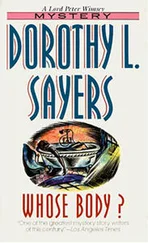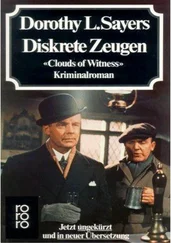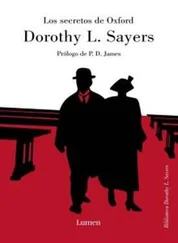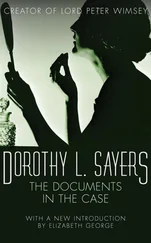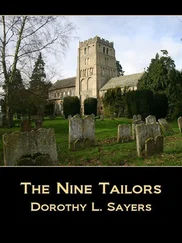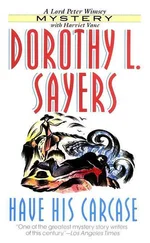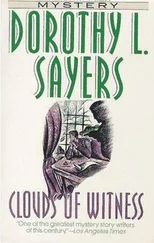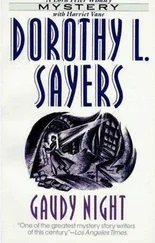‘Why so?’ inquired the Sergeant.
‘For the reasons I gave you before,’ said Wimsey. ‘And there’s another small point — not very much in itself, but supporting the same conclusion. The whole thing looks — and is meant to look — as though Campbell had got up from his painting, stepped back to get a better view of his canvas, missed his footing and fallen down. But his palette and painting-knife were laid down on his stool. Now it’s far more likely that, if he were doing that, he would have kept his palette on his thumb and his knife or brush in his hand, ready to make any little extra touch that was required. I don’t say he might not have laid them down. I would only say it would have looked more natural if we had found the palette beside the body and the knife half-way down the slope.’
‘Ay,’ said Ross. ‘I’ve seen ’em dew that. Steppin’ back wi’ their eyes half-shut and then hoppin’ forward wi’ the brush as if they was throwin’ darts.’
Wimsey nodded.
‘It’s my theory,’ he said, ‘that the murderer brought the body here this morning in Campbell’s own car. He was wearing Campbell’s soft hat and that foul plaid cloak of his so that anybody passing by might mistake him for Campbell. He had the body on the floor of the tonneau and on top of it he had a push-cycle, which has left tarry marks on the cushions. Tucked in over the whole lot he had this rug, which has tar-marks on it too. Then I think he dragged out the corpse, carried it up the sheep-track on his shoulders and tumbled it into the burn. Or possibly he left it lying on the top of the bank, covered with the rug. Then, still wearing Campbell’s hat and cloak, he sat down and faked the picture. When he had done enough to create the impression that Campbell had been here painting, he took off the cloak and hat, left the palette and knife on the seat and went away on his push-bike. It’s a lonely spot, here. A man might easily commit a dozen murders, if he chose his time well.’
‘That’s a verra interesting theory,’ said Dalziel.
‘You can test it,’ said Wimsey. ‘If anybody saw Campbell this morning to speak to, or close enough to recognise his face, then, of course, it’s a wash-out. But if they only saw the hat and cloak, and especially if they noticed anything bulky in the back of the car with a rug over it, then the theory stands. Mind you, I don’t say the bicycle is absolutely necessary to the theory, but it’s what I should have used in the murderer’s place. And if you’ll look at this smear of tar under the lens, I think you’ll see traces of the tread of a tyre.’
‘I’ll no say ye’re no richt,’ said Dalziel.
‘Very well,’ said Wimsey. ‘Now let’s see what our murderer has to do next.’ He flapped the map impressively, and the two policemen bent their heads over it with him.
‘Here he is,’ said Wimsey, ‘with only a bicycle to help or hinder him, and he’s got to establish some sort of an alibi. He may not have bothered about anything very complicated, but he’d make haste to dissociate himself from this place as quickly as possible. And I don’t fancy he’d be anxious to show himself in Newton-Stewart or Creetown. There’s nowhere much for him to go northward — it only takes him up into the hills round Larg and the Rhinns of Kells. He could go up to Glen Trool, but there’s not much point in that; he’d only have to come back the same way. He might, of course, follow the Cree back on the eastern bank as far as Minniegaff, avoiding Newton-Stewart, and strike across country to New Galloway, but it’s a long road and keeps him hanging about much too close to the scene of the crime. In my opinion, his best way would be to come back to the road and go north-west by Bargrennan, Cairnderry, Creeside and Drumbain, and strike the railway at Barrhill. That’s about nine or ten miles by road. He could do it, going briskly, in an hour, or, as it’s a rough road, say an hour and a half. Say he finished the painting at 11 o’clock, that brings him to Barrhill at 12.30. From there he could get a train to Stranraer and Port Patrick, or even to Glasgow, or, of course, if he dumped the bicycle, he might take a motor-bus to somewhere. If I were you, I’d have a hunt in that direction.’
The Sergeant glanced at his colleagues and read approval in their eyes.
‘And whae d’ye think, my lord, wad be the likeliest pairson to hae committed the crime?’ he inquired.
‘Well,’ said Wimsey, ‘I can think of half a dozen people with perfectly good motives. But the murderer’s got to be an artist, and a clever one, for that painting would have to pass muster as Campbell’s work. He must know how to drive a car, and he must possess, or have access to, a bicycle. He must be fairly hefty, to have carried the body up here on his back, for I see no, signs of dragging. He must have been in contact with Campbell after 9.15 last night, when I saw him leave the McClennan Arms alive and kicking. He must know the country and the people pretty well, for he obviously knew that Campbell lived alone with only a charwoman coming in, so that his early morning departure would surprise nobody. He either lives in the same way himself, or else had a very good excuse for being up and out before breakfast this morning. If you find a man who fulfils all these conditions, he’s probably the right one. His railway-ticket, if he took one, ought to be traceable. Or it’s quite possible I may be able to put my finger on him myself, working on different lines and with rather less exertion.’
‘Och, weel,’ said the Sergeant, ‘if ye find him, ye’ll let us know.’
‘I will,’ said Wimsey, ‘though it will be rather unpleasant, because ten to one he’ll be some bloke I know and like much better than Campbell. Still, it doesn’t do to murder people, however offensive they may be. I’ll do my best to bring him in captive to my bow and spear — if he doesn’t slay me first.’
FERGUSON
On his way back to Kirkcudbright, it occurred to Wimsey that it was more than time for tea, and, further, that it would be a good idea to visit Campbell’s cottage. He accordingly pulled up at the Anwoth hotel, and while voraciously filling himself up with potato-scones and ginger-cake, made out a rough list of possible suspects.
At the end of the meal, the list stood as follows:
Living in Kirkcudbright : 1. Michael Waters — 28 — 5 foot 10 inches — unmarried — living in lodgings with private latch-key — landscape painter — boasts of being able to counterfeit Campbell’s style — quarrelled with Campbell previous night and threatened to break his neck. 2. Hugh Farren — 35 — 5 foot 9 inches — figure and landscape painter — particularly broad in the shoulder — married — known to be jealous of Campbell — lives alone with a wife who is apparently much attached to him. 3. Matthew Gowan — 46 — 6 foot 1 inch — figure and landscape painter, also etcher — unmarried — house with servants — wealthy — known to have been publicly insulted by Campbell — refuses to speak to him.
Living in Gatehouse of Fleet : 4. Jock Graham — 36 — 5 foot 11 inches — unmarried — staying at Anwoth Hotel — portrait painter — keen fisherman — reckless — known to be carrying on a feud with Campbell and to have ducked him in the Fleet after being assaulted by him. 5. Henry Strachan — 38 — 6 foot 2 inches — married — one child, one servant — portrait painter and illustrator — secretary of golf-club — known to have quarrelled with Campbell and turned him off the golf-course.
The list had reached this stage when the landlord of the hotel came in. Wimsey gave him the latest news of the Campbell affair, without, however, referring to the murder theory, and remarked that he thought of running along to Campbell’s house, to see if anything was known there about his movements.
Читать дальше

